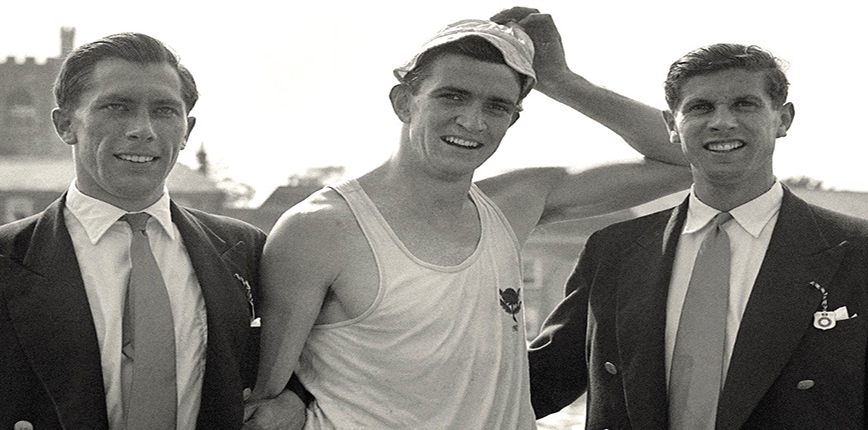
As the Leander Club archivist, I regularly field questions about rowing and its history.
The following particular query started, innocuously enough, just before Christmas: “Hi, I found some old oars. They’re painted with Leander Club, European Championships and Goblet and Nickalls Cup, both from 1957 with D A T Leadley and C G V Davidge. Any idea what they are?
“I was about to toss them in the bin but figured I’d check first.”
I quickly replied to the enquirer, called Phil, to tell him what many rowing veterans will know only too well — that Tony Leadley and Christopher Davidge were two of the most successful British oarsmen of the post-war years.
Both had rowed in the Boat Race, though never against each other (Leadley rowed for Cambridge in 1953 and Davidge three times for Oxford between 1949 and 1952) before they went on to their illustrious international careers.
The two men trained at Henley as part of the Barn Cottage group, based at the home of one of the group’s pro-tagonists, Teddy Selwyn.
This elite corps also included Sam Mackenzie, who would go on to win the Diamond Challenge for men’s single sculls at the royal regatta six times in succession, a record that still stands.
In 1957 and 1958, Leadley and Davidge, by then racing as Leander, won the Silver Goblets & Nickalls’ Challenge Cup for coxless pairs at Henley.
They used their first win as a springboard to take them to the European Championships almost two months later in Duisburg.
The race for the leading positions finished exactly as it had done at Henley with the Austrian pair of Alfred Sageder and Josef Kloimstein taking second place behind Leadley and Davidge on both occasions.
In the single sculls, Mackenzie won gold for Australia with the Soviet sculler Vyacheslav Ivanov in third place. The European gold medals won by Leadley and Davidge were mounted, framed and hung on the wall of the Leander dining room where they have remained ever since.
I knew that Christopher Davidge died in 2014 but that Tony Leadley was still alive and living in Australia, aged 96.
I told this to Phil and then moved on to more practical matters.
“Can you tell me about the current state of these oars, and where you found them,” I asked.
“I’m assuming they need a bit of work to clean them up? Whereabouts in the country are you?”
Phil replied: “I’m actually from Port Stephens, New South Wales. We’ve recently been cleaning out a property and stumbled across them.
“I just thought maybe whoever they are might have family that’s interested in having them.”
The photo he attached confirmed what I had suspected — that the blades were in a sorry state and a far cry from the prestigious events where they had been earned.
I immediately emailed Tony Leadley to ask for the back story to these blades since I guessed that he must have taken them with him when he moved to Australia.
Might he have mislaid them, I asked, or maybe he had decided he no longer had space to store them? Less than 24 hours later I had a reply.
Tony said: “The oars were in a storage facility in Sydney some 50 years ago, along with some other furniture that was too big for the new unit I had moved into.
“Someone broke into the place and, along with some of the furniture, took the oars and some other stuff of no great importance.
“I tried in vain to find out who took them. I never saw them again.”
Tony reckoned there were originally four blades, while he left several more in England where his mother distributed them to various clubs after his father died and she sold the house.
The following day Tony reported that he had spoken to Phil, who promised to bring the blades over when he made one of his frequent trips to Sydney, just over 100 miles away.
Meanwhile, Tony was able to tell me that he had arrived in Oz in December 1962, just missing the big freeze in Britain which lasted three months.
He was accompanied by his wife and three children, a dog, a cat, a container of furniture and those blades.
In January 1963 he started work at ATN 7, a TV station in Sydney. He spent two years there in the PR depart-ment before starting his own PR company that kept him busy for the rest of his working life.
Tony said: “My clients were all interesting and over the years I became involved in the acting world and per-formed in many TV series and a great number of TV commercials.”
He eventually retired at the age of 90.
Meanwhile, the blades arrived in Sydney and were given a light dusting before, at my request, a photoshoot was organised with Tony resplendent in Leander No. 1 rig despite the heat of the Australian sun.
Tony is now the oldest living Blue from either university to have rowed in the Boat Race.
He last came to the UK in 2018 for the 65th anniversary of the great Cambridge win of 1953 when they tri-umphed by more than eight lengths over the old adversary.
Some members of the crew had already passed away and the survivors had plans to reconvene for the 70th anniversary but it was not to be.
“We are now down to only three of us still standing and it seemed too daunting as age takes its toll,” said Tony.
By Robert Treharne Jones
This article was first published on the rowing history website Hear The Boat Sing.




.jpg)